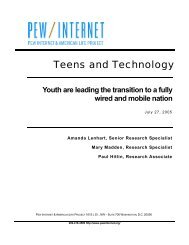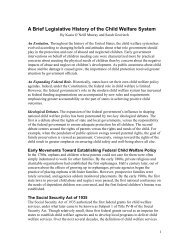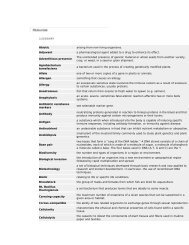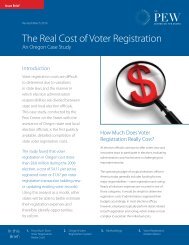Protecting Western Australia's Big Blue Backyard - The Pew ...
Protecting Western Australia's Big Blue Backyard - The Pew ...
Protecting Western Australia's Big Blue Backyard - The Pew ...
Create successful ePaper yourself
Turn your PDF publications into a flip-book with our unique Google optimized e-Paper software.
105 ISLANDS AND A PIRATE<br />
<strong>The</strong> Leeuwin Current has lost some of its heat<br />
and strength by the time it reaches Esperance,<br />
but at 20°C in summer it is still warmer than the<br />
surrounding waters.<br />
It is now on its way to the Great Australian <strong>Big</strong>ht,<br />
but the islands that were home to Australia’s<br />
only pirate, Black Jack Anderson, are in its path.<br />
In the early 19th century Black Jack lived on Middle<br />
Island in the Recherche Archipelago and attacked<br />
passing ships.<br />
<strong>The</strong> warm water and marine life transported by<br />
the Leeuwin Current, and the shelter provided<br />
by the many islands and reefs of the Recherche<br />
Archipelago, support a wonderful mix of temperate<br />
and subtropical species. To the south of the<br />
islands, eddies and upwellings attract life to the<br />
surface waters of the upper continental slope and<br />
its canyons.<br />
<strong>The</strong> archipelago is another significant hotspot for<br />
marine life in the region and contains the region’s<br />
most extensive area of reef. At the last count there<br />
were at least 263 fish species, 347 mollusc species<br />
and 242 algae species. Almost 30 per cent of<br />
<strong>Western</strong> Australia’s endemic fish are found here,<br />
and the archipelago provides important rookeries<br />
for protected shearwaters and terns and nesting<br />
areas for white-bellied sea-eagles.<br />
<strong>The</strong> sheltered islands are a great place for<br />
travelling marine animals to rest or breed. Southern<br />
right whales calve here and there is a significant<br />
Australian sea lion breeding colony. <strong>The</strong>se sea lions<br />
can only be found in Australia’s southern waters<br />
living on scattered islands.<br />
Scientists believe the separate sea lion colonies<br />
stagger their breeding seasons to ensure there<br />
is plenty of food to go around. Australian sea<br />
lion populations are only slowly recovering from<br />
the decimation of 19th century sealing. Now<br />
entanglement in fishing nets and competition with<br />
fishers for fish are their main threats.<br />
When rhodoliths, sponges, bryozoans, barnacles,<br />
crabs and seastars die, the calcium carbonate in<br />
their bodies breaks down and forms carbonate<br />
sands that blanket the sea floor and help cycle<br />
nutrients. Most of the region’s sea floor is covered<br />
by sand which is washed off the shelf, down the<br />
slope, into the canyons and then out on to the<br />
abyssal plain.<br />
<strong>The</strong> shelf that extends to the east of the Recherche<br />
Archipelago and across the Great Australian <strong>Big</strong>ht<br />
is now recognised as the world’s largest area of<br />
cool-water carbonate sediments.<br />
<strong>The</strong>se sandy and muddy sediments provide soft<br />
habitats for burrowing animals like the giant crab,<br />
worms and microscopic animals that live below<br />
the surface of the sea floor. Little is known of these<br />
creatures, although it is thought there could be<br />
more than 100 million species worldwide—mostly<br />
microscopic animals. Many of these animals rely on<br />
oxygen trapped between the sand grains and food<br />
that sinks to the sea floor. In one study, more than<br />
800 species were found in just 10 square metres.<br />
Scientists suspect that the creatures living in the<br />
mud and sand of the sea floor could be highly<br />
vulnerable to disturbance. Drilling in a petroleum<br />
field near Portland in Victoria caused the numbers<br />
of some species to drop by nearly 90 per cent for<br />
several months. <strong>The</strong> oil and gas industry is likely to<br />
expand in the Kalbarri to Eucla region.<br />
<strong>The</strong> sea floor communities on the continental shelf,<br />
shelf break and slope are the foundations of many<br />
food chains in the region’s marine environment and<br />
critical to its good health. But they are also fragile<br />
and in need of strong protection.<br />
THE LEEUWIN CURRENT’S LONG<br />
AND IMPORTANT JOURNEY<br />
After the Recherche Archipelago the Leeuwin<br />
Current leaves the Kalbarri to Eucla region and<br />
continues east across the Great Australian <strong>Big</strong>ht<br />
to its end on the west coast of Tasmania.<br />
On its long and important journey through<br />
<strong>Western</strong> Australia’s big blue backyard, the<br />
Leeuwin current connects and influences the<br />
marine life and people of the region. <strong>The</strong> current<br />
is integral to the global uniqueness of the Kalbarri<br />
to Eucla region’s marine life.<br />
<strong>The</strong> Leeuwin Current brings the region clear,<br />
warm and low-salinity water and mixes the<br />
eggs and larvae of tropical marine life with<br />
subtropical and temperate species. It passes the<br />
most southerly tropical coral reefs in the Indian<br />
Ocean, internationally significant inshore lagoons,<br />
the largest Australian canyon, the deepest<br />
point in Australia’s oceans, the nation’s highest<br />
underwater mountain range and the feeding area<br />
of the world’s largest and one of the world’s rarest<br />
animals.<br />
It also witnesses many of the threats now facing<br />
the region’s marine environment including<br />
overfishing, bycatch, coastal development and<br />
water pollution and is itself under threat from<br />
climate change.<br />
People living along the Kalbarri to Eucla coast<br />
have developed a strong connection with and<br />
reliance on the region’s marine environment.<br />
<strong>The</strong>ir futures are inextricably linked.<br />
<strong>The</strong> western wobbegong is unique to<br />
<strong>Western</strong> Australia. Seven of the world’s<br />
ten wobbegong species are found in the<br />
waters off south-west Australia<br />
© marinethemes.com / Ray Delamare<br />
Recently a team of scientists found 450 species of<br />
sponges, extensive beds of rhodoliths (coralline<br />
algae) and a wide range of soft corals in the<br />
Recherche Archipelago. <strong>The</strong> discovery of the<br />
rhodoliths was a first for the area and some have<br />
been dated at 720 years of age.<br />
Rhodoliths are free-living algae that secrete a<br />
coralline skeleton, sometimes resemble golf balls<br />
and can grow up to five centimetres across. With<br />
sponges and soft corals they provide shelter,<br />
nursery and feeding areas for marine spiders,<br />
snails, worms and juvenile scallops. <strong>The</strong>y are rare in<br />
Australia and highly vulnerable to bottom trawling.<br />
52
















